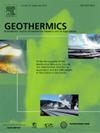基于实验和机器学习的高塑性土壤热扩散系数估计
IF 3.9
2区 工程技术
Q3 ENERGY & FUELS
引用次数: 0
摘要
在许多居民区,电力公司越来越多地选择地下电缆进行中高压输电,以减轻与天气有关的中断,并确保安全配电。热扩散系数(TD)是影响地下电力电缆、地源热泵、埋地热流体管道等热敏性地下结构与周围土壤之间传热过程的重要热物性参数。土壤的TD受多种因素的影响,包括密度、含水量、饱和度、有机含量以及粘土、沙子和淤泥的比例,这使得直接测量既有挑战性,也具有内在的不确定性。为了解决这些限制,本研究探索了集成极端梯度提升(XGBoost)算法的先进混合机器学习模型在高塑性土壤中估计TD的应用。TD测量采用双探针法(KD2-Pro),在控制温度和湿度的无光照房间中进行。共有180个实验数据集,包括膨润土、膨润土-粉煤灰(粉砂)混合物和膨润土-砂混合物,用于训练和验证模型。使用几个性能指标、散点图和回归误差特征(REC)曲线评估模型的性能和预测精度。预测证实,整合元启发式优化显著提高了基准XGBoost模型的性能。具体而言,XGBoost-SSO优于其他模型(训练R²= 0.9744,测试R²= 0.9146),是最有效的土壤热扩散率预测模型。SHapely加性解释(SHAP)分析表明,Sr(+0.072)、Sand(+0.032)和粉砂(+0.017)是影响高塑性土壤TD的最主要特征。虽然已开发的模型提供了高度准确的预测,但其固有的“黑箱”性质对工程应用的可解释性提出了挑战。为了减轻这种情况,在训练模型的基础上开发了开源图形用户界面(GUI),使从业者能够有效地生成精确的TD预测。本文章由计算机程序翻译,如有差异,请以英文原文为准。
Experimental and machine learning-based estimation of the thermal diffusivity of high-plastic soil
In many residential areas, power companies are increasingly opting for underground cables for medium- and high-voltage electricity transmission to mitigate weather-related disruptions and ensure safe electricity distribution. Thermal diffusivity (TD) is a critical thermophysical parameter influencing heat transfer processes between heat-sensitive subsurface structures such as underground power cables, ground source heat pumps, and buried hot fluid pipelines and the surrounding soil. The TD of soil is governed by multiple factors, including density, water content, degree of saturation, organic content, and proportions of clay, sand, and silt, rendering its direct measurement both challenging and inherently uncertain. To address these limitations, the present study explores the application of advanced hybrid machine learning models integrating the extreme gradient boosting (XGBoost) algorithm for estimating TD in high-plastic soils. TD measurements were obtained using the dual-probe method (KD2-Pro) in a sunlight-free room under controlled temperature and humidity. A total of 180 experimental datasets comprising bentonite, bentonite–fly ash (silty sand) mixtures, and bentonite–sand mixtures were used to train and validate the models. The model performance and prediction accuracy were evaluated using several performance metrics, scatter plots, and regression error characteristic (REC) curves. The predictions confirm that the integration of metaheuristic optimization significantly enhances the performance of the baseline XGBoost model. Specifically, XGBoost-SSO outperforms the other models (training R² = 0.9744, testing R² = 0.9146), making it the most effective model for predicting soil thermal diffusivity. Moreover, SHapely Additive exPlanations (SHAP) analysis identified Sr (+0.072), Sand (+0.032), and Silt (+0.017) as the most influential features positively impacting the TD of high-plastic soil. While the developed models provide highly accurate forecasts, their inherent "black-box" nature presents interpretability challenges for engineering applications. To mitigate this, an open-source graphical user interface (GUI) was developed on the basis of the trained models, enabling practitioners to generate precise TD predictions efficiently.
求助全文
通过发布文献求助,成功后即可免费获取论文全文。
去求助
来源期刊

Geothermics
工程技术-地球科学综合
CiteScore
7.70
自引率
15.40%
发文量
237
审稿时长
4.5 months
期刊介绍:
Geothermics is an international journal devoted to the research and development of geothermal energy. The International Board of Editors of Geothermics, which comprises specialists in the various aspects of geothermal resources, exploration and development, guarantees the balanced, comprehensive view of scientific and technological developments in this promising energy field.
It promulgates the state of the art and science of geothermal energy, its exploration and exploitation through a regular exchange of information from all parts of the world. The journal publishes articles dealing with the theory, exploration techniques and all aspects of the utilization of geothermal resources. Geothermics serves as the scientific house, or exchange medium, through which the growing community of geothermal specialists can provide and receive information.
 求助内容:
求助内容: 应助结果提醒方式:
应助结果提醒方式:


